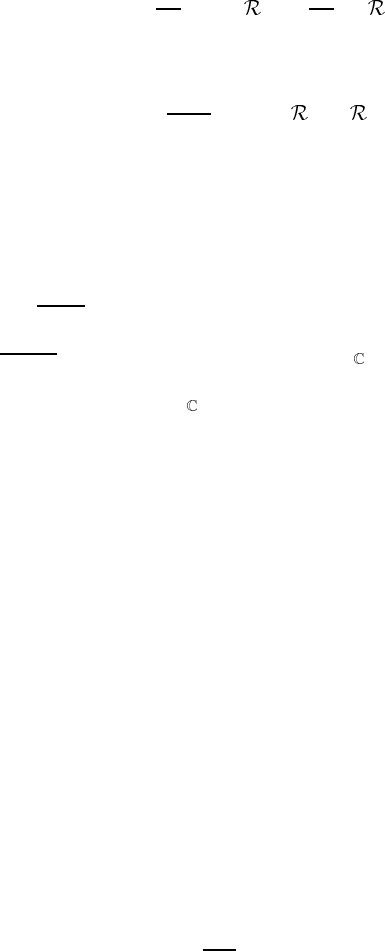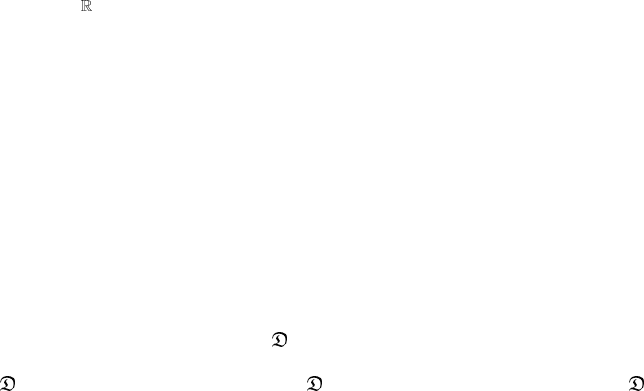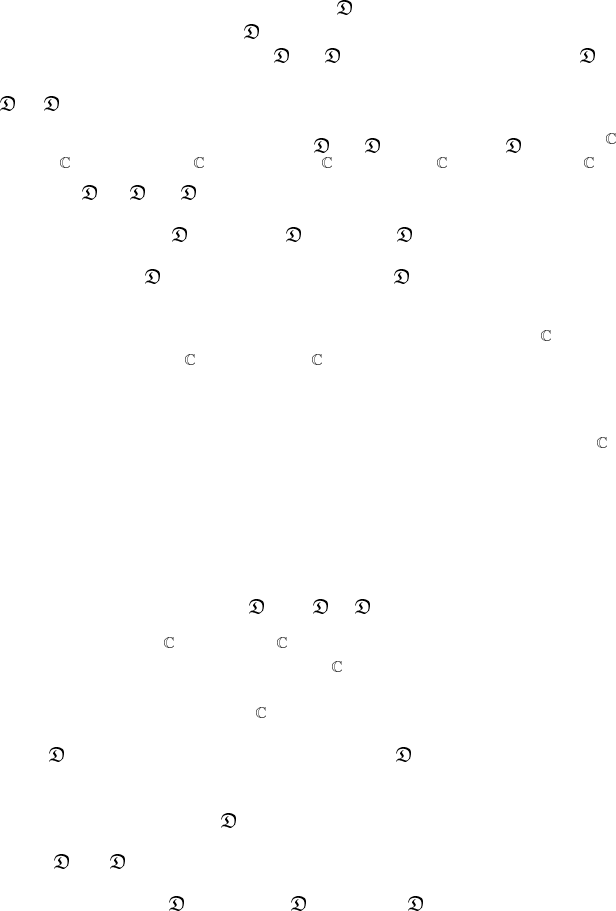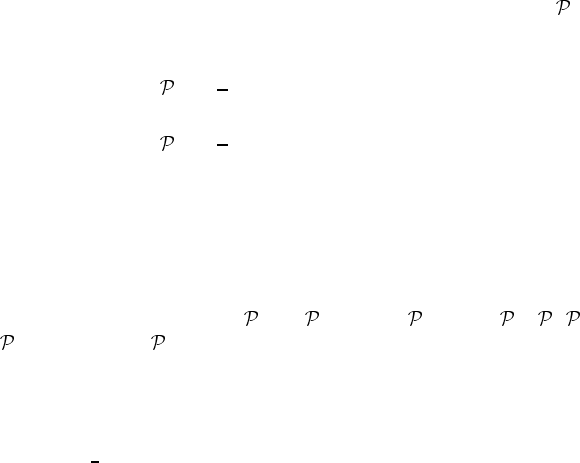Nakahara M. Geometry, Topology and Physics
Подождите немного. Документ загружается.


Example 12.3. Let M be a two-dimensional orientable manifold without
boundary. Equation (12.41) reads
χ(M) =
1
4π
M
αβ
αβ
=
1
2π
M
12
(12.42a)
which is the celebrated Gauss–Bonnet theorem. For dim M = 4, it reads as
χ(M) =
1
32π
2
M
αβγ δ
αβ
∧
γδ
.(12.42b)
12.4 The Dolbeault complex
We recall some elementary facts about complex manifolds (see chapter 8 for
details). Let M be a compact complex manifold of complex dimension m without
a boundary. Let z
µ
= x
µ
+ iy
µ
be the local coordinates and ¯z
µ
= x
µ
− iy
µ
their complex conjugates. TM
+
denotes the tangent bundle spanned by {∂/∂z
µ
}
and TM
−
= TM
+
the complex conjugate bundle spanned by {∂/∂¯z
µ
}.The
dual of TM
+
is denoted by T
∗
M
+
and spanned by {dz
µ
} while that of TM
−
is
T
∗
M
−
= T
∗
M
+
spanned by {d¯z
µ
}. The space
r
(M) of complexified r -forms
is decomposed as
r
(M) =⊕
p+q=r
p,q
(M)
where
p,q
(M) is the space of the ( p, q)-forms, which is spanned by a basis of
the form
dz
µ
1
∧ ...∧ dz
µ
p
∧ d¯z
ν
1
∧ ...∧ d¯z
ν
q
.
The exterior derivative is decomposed as d ≡ ∂ +
¯
∂ where
∂ = dz
µ
∧ ∂/∂z
µ
¯
∂ = d¯z
µ
∧ ∂/∂¯z
µ
.
They satisfy ∂
¯
∂ +
¯
∂∂ = ∂
2
=
¯
∂
2
= 0. We have the sequences
···
¯
∂
→
p,q
(M)
¯
∂
→
p,q+1
(M)
¯
∂
→··· (12.43a)
···
∂
→
p,q
(M)
∂
→
p+1,q
(M)
∂
→···. (12.43b)
We are interested in the first sequence with p = 0,
···
¯
∂
→
0,q
(M)
¯
∂
→
0,q+1
(M)
¯
∂
→···. (12.44)
This sequence is called the Dolbeault complex.
To show that (12.44) is an elliptic complex, we compute the symbol for
¯
∂.
Let ξ = ξ
0,1
+ ξ
1,0
be a real one-form at p ∈ M,whereξ
0,1
∈
0,1
p
(M) and
ξ
1,0
= ξ
0,1
∈
1,0
p
(M).

Take an anti-holomorphic r -form ω ∈
0,r
(M).Wefind
σ(
¯
∂,ξ)ω =
¯
∂( f ˜s) =
¯
∂ f ∧˜s + f
¯
∂ ˜s|
p
= ξ
0,1
∧ ω
where f (p) = 0,
¯
∂ f (p) = ξ
0,1
, ˜s ∈
0,r
(M) and ˜s( p) = ω.Wehave
σ(
¯
∂,ξ) = ξ
0,1
∧ . (12.45)
From a similar argument to that given in the previous section, it follows that the
symbol (12.45) is elliptic. Thus, the Dolbeault complex (12.44) is an elliptic
complex.
The AS index theorem takes the form
ind
¯
∂ =
M
ch
r
(−1)
r
∧
r
T
∗
M
−
Td(TM
)
e(TM)
vol
. (12.46)
The LHS is computed as follows. We first note that
ker
¯
∂
r
/im
¯
∂
r−1
= H
0,r
(M)
where H
0,r
(M) is the
¯
∂-cohomology group. Then the LHS is
ind
¯
∂ =
n
r=0
(−1)
r
b
0,r
(12.47)
where b
0,r
≡ dim H
0,r
(M) is the Hodge number. This index is called the
arithmetic genus of M.
Simplification of the topological index can be carried out as in the case of
the de Rham complex. We refer the reader to Shanahan (1978) for the technical
details. We have
n
r=1
(−1)
r
b
0,r
=
M
Td(TM
+
) (12.48)
where Td(TM
+
) is the Todd class of TM
+
.
12.4.1 The twisted Dolbeault complex and the Hirzebruch–Riemann–Roch
theorem
In the Dolbeault complex, we may replace
0,r
(M) by the tensor product bundles
0,r
(M) ⊗ V ,whereV is a holomorphic vector bundle over M,
···
¯
∂
V
→
0,r−1
(M) ⊗ V
¯
∂
V
→
0,r
(M) ⊗ V
¯
∂
V
→···. (12.49)
The AS index theorem of this complex reduces to the Hirzebruch–Riemann–
Roch theorem,
ind
¯
∂
V
=
M
Td(TM
+
)ch(V ). (12.50)

For example, if m = dim M = 1, we have
ind
¯
∂
V
=
1
2
dim V
M
c
1
(TM
+
) +
M
c
1
(V )
= (2 − g) dim V +
M
i
2π
(12.51)
since it can be shown that
M
c
1
(TM
+
) =
M
e(TM) = 2 − g
g being the genus of M.
12.5 The signature complex
12.5.1 The Hirzebruch signature
Let M be a compact orientable manifold of even dimension, m = 2l.Let[ω] and
[η] be the elements of the ‘middle’ cohomology group H
l
(M; ). We consider a
bilinear form H
l
(M; ) × H
l
(M; ) → defined by
σ([ω], [η]) ≡
M
ω ∧ η (12.52)
cf example 11.8. This definition is independent of the representatives of [ω] and
[η]. The form σ is symmetric if l is even (m ≡ 0 mod 4) and anti-symmetric if
l is odd (m ≡ 2 mod 4). Poincar´e duality shows that the bilinear form σ has the
maximal rank b
l
= dim H
l
(M; ) and is, hence, non-degenerate. If l ≡ 2k is
even, the symmetric form σ has real eigenvalues, b
+
of which are positive and b
−
of which are negative (b
+
+ b
−
= b
l
). The Hirzebruch signature is defined by
τ(M) ≡ b
+
− b
−
. (12.53)
If l is odd, τ(M) is defined to vanish (an anti-symmetric form has pure imaginary
eigenvalues). In the following, we set l = 2k.
The Hodge ∗ satisfies ∗
2
= 1whenactingona2k-form in a 4k-dimensional
manifold M and hence ∗ has eigenvalues ±1. Let Harm
2k
(M) be the set of
harmonic 2k-forms on M. We note that Harm
2k
(M)
∼
=
H
2k
(M; ) and each
element of H
2k
(M; ) has a unique harmonic representative. Harm
2k
(M) is
separated into disjoint subspaces,
Harm
2k
(M) = Harm
2k
+
(M) ⊕ Harm
2k
−
(M) (12.54)
according to the eigenvalue of ∗. This separation block diagonalizes the bilinear
form σ . In fact, for ω
±
∈ Harm
2k
±
(M),
σ(ω
+
,ω
+
) =
M
ω
+
∧ ω
+
=
M
ω
+
∧∗ω
+
= (ω
+
,ω
+
)>0

where (ω
+
,ω
+
) is the standard positive-definite inner product defined by (7.181).
We also find
σ(ω
−
,ω
−
) =−
M
ω
−
∧∗ω
−
=−(ω
−
,ω
−
)<0
σ(ω
+
,ω
−
) =−
M
ω
+
∧∗ω
−
=−
M
ω
−
∧∗ω
+
=−σ(ω
+
,ω
−
) = 0
where we have noted that α ∧∗β = β ∧∗α for any forms α and β. Hence,
σ is block diagonal with respect to Harm
2k
+
(M) ⊕ Harm
2k
−
(M) and, moreover,
b
±
= dim Harm
2k
±
(M).Nowτ(M) is expressed as
τ(M) = dim Harm
2k
+
(M) − dim Harm
2k
−
(M). (12.55)
Exercise 12.2. Let dim M = 4k. Show that
τ(M) = χ(M) mod 2. (12.56)
[Hint: Use the Poincar´e duality to show that χ(M) = b
2k
mod 2.]
12.5.2 The signature complex and the Hirzebruch signature theorem
Let M be an m-dimensional compact Riemannian manifold without a boundary
and let g be the given metric. Consider an operator
≡ d + d
†
. (12.57)
is a square root of the Laplacian:
2
= dd
†
+ d
†
d = . To show that
is elliptic, it suffices to verify that is elliptic since the symbol of a product of
operators is the product of symbols. Let us compute the symbol of . As for d,
we have σ(d,ξ)ω = ξ ∧ ω.Asford
†
, it can be shown that (Palais 1965, pp77–8)
σ(d
†
,ξ) =−i
ξ
. (12.58)
Here i
ξ
:
r
p
(M) →
r−1
p
(M) is an interior product defined by (cf. (5.79))
i
ξ
(dx
µ
1
∧ ...∧ dx
µ
r
)
≡
r
j =1
(−1)
j +1
g
µ
j
µ
ξ
µ
dx
µ
1
∧ ...∧ d ˆx
µ
j
∧ ...∧ dx
µ
r
where the one-form under ˆ is omitted and we put ξ = ξ
µ
dx
µ
. Now the symbol
of the Laplacian is obtained from (12.58) as
σ(,ξ)ω = σ(dd
†
+ d
†
d,ξ)ω =−[ξ ∧ i
ξ
(ω) +i
ξ
(ξ ∧ ω)]
=−i
ξ
(ξ) ∧ ω =−ξ
2
ω

where ω is an arbitrary r-form and the norm is taken with respect to the given
Riemannian metric. Finally, we obtain
σ(,ξ) =−ξ
2
. (12.59)
Thus, the Laplacian is elliptic and so is
= d +d
†
.
Since the Laplacian =
2
is self-dual on
∗
(M), the index of vanishes
trivially. It is also observed that
=
†
on
∗
(M) and, hence, ind = 0.
To construct a non-trivial index theorem, we have to find a complex on which
=
†
.
Exercise 12.3. Consider the restriction
e
of to even forms,
e
:
e
(M) →
o
(M) where
e
(M) ≡⊕
2i
(M) and
o
(M) ≡⊕
2i+1
(M) .The
adjoint of
e
is
o
≡
e†
:
o
(M)
C
→
e
(M)
C
. Show that
ind
e
= dim ker
e
− dim ker
o
= χ(M).
[Hint: Prove ker
e
=⊕Harm
2i
(M) and ker
o
=⊕Harm
2i+1
(M).This
complex, although non-trivial, does not yield anything new.]
If dim M = m = 2l,wehave∗∗η = (−1)
r
η for η ∈
r
(M) .Wedefine
an operator π :
r
(M) →
m−r
(M) by
π ≡ i
r(r−1)+l
∗ . (12.60)
Observe that π is a ‘square root’ of (−1)
r
∗∗=1. In fact, for ω ∈
r
(M) ,
π
2
ω = i
r(r−1)+l
π(∗ω) = i
r(r−1)+l+(2l−r)(2l−r−1)+l
∗∗ω
= i
2r
2
∗∗ω = (−1)
r
∗∗ω = ω (12.61)
where we have noted that r ≡ r
2
mod 2. We easily verify (exercise) that
{π,
}=π + π = 0. (12.62)
Let π act on
∗
(M) =⊕
r
(M) .Sinceπ
2
= 1, the eigenvalues of π are ±1.
Then we have a decomposition of
∗
(M) into the ±1 eigenspaces
±
(M) of π
as
∗
(M) =
+
(M) ⊕
−
(M). (12.63)
Since
anti-commutes with π, the restriction of to
+
(M) defines an elliptic
complex called the signature complex,
+
:
+
(M) →
−
(M) (12.64)
where
+
≡ |
+
(M)
. The index of the signature complex is
ind
+
= dim ker
+
− dim ker
−
= dim Harm(M)
+
− dim Harm(M)
−
(12.65)

where
−
≡
†
+
:
−
(M) →
+
(M) and Harm(M)
±
≡{ω ∈
±
(M)|
±
ω =
0}. On the RHS of (12.65), all the contributions except those from the harmonic
l-forms cancel out. To see this, we separate ker
+
and ker
−
as
ker
±
= Harm
l
(M)
±
⊕
0≤r<l
[Harm
r
(M)
±
⊕ Harm
m−r
(M)
±
]
where Harm
r
(M)
±
≡ Harm(M)
±
∩
r
(M).Ifω ∈ Harm
r
(M),wehave
ω±πω ∈ Harm
r
(M)
±
⊕Harm
m−r
(M)
±
.Thenamapω+πω → ω−πω defines
an isomorphism between Harm
r
(M)
+
⊕ Harm
m−r
(M)
+
and Harm
r
(M)
−
⊕
Harm
m−r
(M)
−
. Now the index simplifies as
ind
+
= dim Harm
2k
(M)
+
− dim Harm
2k
(M)
−
(12.66)
where we put l = 2k as before (the index vanishes if l is odd). It is important to
note that Harm
2k
(M)
±
= Harm
2k
±
(M) since π =∗in Harm
2k
(M), see (12.54).
Now the index (12.66) reduces to the Hirzebruch signature,
ind
+
= τ(M). (12.67)
The derivation of the topological index is rather technical and we simply
quote the result from Shanahan (1978). Let ∧
±
T
∗
M be the subspace of ∧T
∗
M
such that
±
(M) = (M, ∧
±
T
∗
M ).Thenwehave
topological index = (−1)
l
M
ch(∧
+
T
∗
M −∧
−
T
∗
M )
Td(TM
)
e(TM)
vol
= 2
l
M
l
i=1
x
i
/2
tanh x
i
/2
vol
=
M
l
i=1
x
i
tanh x
i
vol
where the last equality is true only for the 2l-forms in the expansion and x
i
=
x
i
(TM ). Now we have obtained the Hirzebruch signature theorem
τ(M) =
M
L(TM)|
vol
(12.68)
where L is the Hirzebruch L-polynomial defined by (11.91). Since L is even in
x
i
, τ(M) vanishes if m = 2 mod 4. For example, τ(M) = 0form = 2. If m = 4,
we have
τ(M) =
M
1
3
p
1
(TM) =−
1
24π
2
tr
2
. (12.69)
As in the case of the Dolbeault complex, we may twist the signature complex,
see Eguchi et al (1980), for example.
12.6 Spin complexes
The final example of classical complexes is the spin complex. This complex is
very important in physics since it describes Dirac fields interacting with gauge
fields and/or gravitational fields.
12.6.1 Dirac operator
Let us consider a spin bundle S(M) over an m-dimensional orientable manifold
M. We shall denote the set of sections of this bundle by (M) = (M, S(M)).
We assume that m = 2l is an even integer. The spin group SPIN(m) is generated
by m Dirac matrices {γ
α
}, which satisfy
γ
α†
= γ
α
(12.70a)
{γ
α
,γ
β
}=2δ
αβ
. (12.70b)
Throughout this chapter we assume that the metric has the Euclidean signature.
The Clifford algebra is generated by
1;γ
α
;γ
α
1
γ
α
2
(α
1
<α
2
);...;
γ
α
1
...γ
α
k
(α
1
<... < α
k
);...;γ
1
...γ
2l
.
The last generator is of particular importance and we define
γ
m+1
≡ i
l
γ
1
...γ
m
. (12.71)
Our convention is such that (γ
m+1
)
2
= I and (γ
m+1
)
†
= γ
m+1
. It can be shown
from the general theory of the Clifford algebra that the γ
x
are represented by
2
l
× 2
l
matrices with complex entries. It is convenient to take a representation of
{γ
x
} such that γ
m+1
is diagonal,
γ
m+1
=
1 0
0 −1
(12.72)
where 1 here is the 2
l−1
× 2
l−1
unit matrix.
Example 12.4. For m = 2, we take
γ
0
= σ
2
γ
1
= σ
1
γ
3
= iγ
0
γ
1
= σ
3
σ
α
being the Pauli matrices,
σ
1
=
01
10
σ
2
=
0 −i
i0
σ
3
=
10
0 −1
.
For m = 4, we may take
γ
β
=
0iα
β
−i ¯α
β
0
α
β
= (I
2
, −iσ ), ¯α
β
= (I
2
, iσ )
γ
5
=−γ
0
γ
1
γ
2
γ
3
=
I
2
0
0 −I
2
.

A Dirac spinor ψ ∈ (M) is an irreducible representation of the Clifford
algebra but not that of SPIN(2l). Irreducible representations of SPIN(2l) are
obtained by separating (M) according to the eigenvalues of γ
m+1
.Since
(γ
m+1
)
2
= I , the eigenvalues of γ
m+1
, called the chirality,mustbe±1. Then
(M) is separated into two eigenspaces
(M) =
+
(M) ⊕
−
(M) (12.73)
where γ
m+1
ψ
±
=±ψ
±
for ψ
±
∈
±
(M). The projection operators
±
onto
±
are given by
+
≡
1
2
(I + γ
m+1
) =
1 0
00
(12.74a)
−
≡
1
2
(I − γ
m+1
) =
00
0 1
. (12.74b)
Thus, we may write
1
ψ
+
=
ψ
+
0
∈
+
(M), ψ
−
=
0
ψ
−
∈
−
(M). (12.75)
The reader should verify that
+
+
−
= 1,(
±
)
2
=
±
,
+ −
=
0,
±
ψ
±
= ψ
±
and
±
ψ
∓
= 0.
The Dirac operator in a curved space is given by (section 7.10)
i
/
∇ψ ≡ iγ
µ
∇
∂/∂x
µ
ψ = iγ
µ
(∂
µ
+ ω
µ
)ψ (12.76)
where ω
µ
=
1
2
iω
µ
αβ
αβ
is the spin connection and γ
µ
= γ
α
e
α
µ
. Let us prove
that i
/
∇ is elliptic. Let f be a function defined near p ∈ M such that f (p) = 0
and iγ
µ
∂
µ
f ( p) = iγ
µ
ξ
µ
≡ i
/
ξ .
2
Takeasection
˜
ψ ∈ (M) such that
˜
ψ(p) = ψ.
From (12.4), we have
σ(i
/
∇,ξ)ψ = i
/
∇( f
˜
ψ)|
p
= (i
/
∇ f )
˜
ψ|
p
= i
/
ξψ
which shows that
σ(i
/
∇,
/
ξ) = i
/
ξ. (12.77)
If we note that
/
ξ
/
ξ = ξ
α
ξ
β
γ
α
γ
β
= ξ
µ
ξ
µ
, we find that (12.77) is invertible for
i
/
ξ = 0, hence i
/
∇ is an elliptic operator.
It can be shown that {γ
α
} is taken in the form
γ
β
=
0iα
β
−i ¯α
β
0
α
†
β
=¯α
β
(12.78)
1
Note the minor abuse of the notation.
2
For a vector A = A
µ
e
µ
, A denotes γ
µ
A
µ
.

see example 12.4 for m = 2 and 4. Then (12.76) becomes
i
/
∇=
0 D
†
D 0
(12.79)
where
D ≡¯α
β
e
β
µ
(∂
µ
+ ω
µ
) D
†
≡−α
β
e
β
µ
(∂
µ
+ ω
µ
). (12.80)
Hence, D
†
is, indeed, the adjoint of D (note that ∂
µ
+ ω
µ
is anti-Hermitian). For
ψ
+
0
∈
+
(M)
we have
i
/
∇
ψ
+
0
=
0 D
†
D 0
ψ
+
0
=
0
Dψ
+
while for
0
ψ
−
∈
−
(M)
we have
i
/
∇
0
ψ
−
=
D
†
ψ
−
0
.
Hence, D = i
/
∇
+
:
+
(M) →
−
(M) and D
†
= i
/
∇
−
:
−
(M) →
+
(M). Now we have a two-term complex
+
(M)
D
−→
←−
D
†
−
(M) (12.81)
called the spin complex. The analytical index of this complex is
ind D = dim ker D − dim ker D
†
= ν
+
− ν
−
(12.82)
where ν
+
(ν
−
) is the number of zero-energy modes of chirality +(−).
Let us apply the AS index theorem to this case. Without getting into the
details of the Clifford algebra and the spin complex, we simply write down the
result. The AS index theorem for the spin complex (12.81) is
ν
+
− ν
−
=
M
ch(
+
(M) −
−
(M))
Td(TM
)
e(TM)
vol
=
M
ˆ
A(TM)|
vol
(12.83)
where
ˆ
A is the Dirac genus defined by (11.94). Since
ˆ
A contains only 4 j -forms,
ν
+
−ν
−
vanishes unless m = 0 mod 4. Of course, this does not necessarily imply
ν
+
= ν
−
= 0. The proof of (12.83) will be given later in sections 12.9 and 12.10.

12.6.2 Twisted spin complexes
In physics, a spinor field may belong to a representation of a group G.For
example, the quark field in QCD belongs to the 3 of SU(3). A spinor which
belongs to a representation of G is a section of the product bundle S(M) ⊗
E,whereE is an associated vector bundle of P(M, G) in an appropriate
representation. The Dirac operator D
E
:
+
(M) ⊗ E → (M)
−
⊗ E in this
case is
D
E
= iγ
α
e
α
µ
(∂
µ
+ ω
µ
+
µ
)
+
(12.84)
where
µ
is the gauge potential on E. The AS index theorem for this twisted spin
complex is
ν
+
− ν
−
=
M
ˆ
A(TM)ch(E)|
vol
. (12.85)
For dim M = 2, we have
ν
+
− ν
−
=
M
ch
1
(E) =
i
2π
M
tr (12.86)
while for dim M = 4,
ν
+
− ν
−
=
M
[ch
2
(E) +
ˆ
A
1
(TM)ch
0
(E)]
=
−1
8π
2
M
tr
2
+
dim E
192π
2
M
tr
2
. (12.87)
Example 12.5. Let
M = T
2l
= S
1
×···×S
1
, -. /
2l times
.
Then we find
ˆ
A(TM) =
ˆ
A
2l
⊕
1
TS
1
=
2l
1
ˆ
A(TS
1
) = 1.
We also have
ˆ
A(TS
2l
) = 1. Accordingly, the index of these bundles is
ν
+
− ν
−
=
M
ch(E)|
vol
. (12.88)
Example 12.6. Let us consider the monopole bundle P(S
2
, U(1)).If is the
local gauge potential, the field strength is
= d . The index theorem is
ν
+
− ν
−
=
i
2π
S
2
=−
1
2π
S
2
F (12.89)
where
= iF. As was shown in section 10.5, the RHS represents the winding
number π
1
(U(1)) = and analytical information (the LHS) is now expressed in
a topological way (the RHS).
